San Francisco’s Golden Gate Bridge was opened in 1937, and pretty much ever since filmmakers and effects artists have been trying to tear it down. Sometimes the cause of destruction has been an earthquakes, sometimes it’s a monster – but the appetite for destruction is clear. From It Came from Beneath the Sea to X-Men: The Last Stand and more recently in Pacific Rim, Godzilla and San Andreas – fxguide traces a VFX history of Hollywood’s desire to bring the Golden Gate down.
It Came From Beneath the Sea (1955)
While it may look slightly hokey by today’s visual effects standards, this Robert Gordon monster flick still has some of the most impressive stop motion work you’ll ever see – and that’s thanks to the genius of Ray Harryhausen. When the tentacled sea beast attacks the Golden Gate Bridge, Harryhausen devised ways to incorporate a miniature model of the monster and a bridge pylon into real footage, thus solidifying the structure as a target for nearly all future movie monsters who visit San Francisco.
Superman (1978)
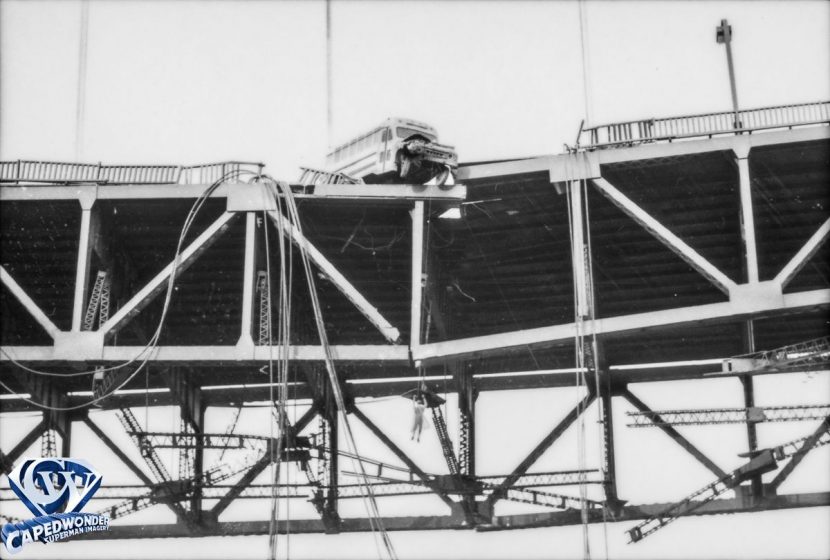
Jump to 1978 when Richard Donner brought us Superman. No, Superman doesn’t destroy the Golden Gate – he saves people from falling off it in a school bus, after a missile is detonated in the San Andreas Fault triggering a series of quakes. The Golden Gate shots were achieved with a combination of giant sets filmed on an airfield in England, and miniatures, one of which was 70 feet long and 20 feet wide, along with back-projection plates. The bridge could have really needed Superman around for the next few decades, though.
The Core (2003)
Sometimes the Golden Gate Bridge just can’t catch a break. Even instability in the Earth’s magnetic field leading to super ultraviolet light storms from the sun can end up targeting the famous structure, at least in Jon Amiel’s The Core. In this case, the light burns through the San Francisco Bay and the Bridge – an effect completed in the film by Computer Cafe. A completely digital model textured with photographic reference served as the basis of its destruction as the bridge melts from the light, with accompanying super-heated water churning underneath.
X-Men: The Last Stand (2006)
Brett Ratner’s take on the X-Men franchise saw Magneto (Sir Ian McKellen) use his magnetic powers to break apart the Golden Gate Bridge and move it to connect to Alcatraz. Creating this scene involved a unique combination of a full-sized bridge section surrounded by greenscreen, large miniatures for crashing sections, and digital handiwork by Framestore showing all the chaos and destruction wrought by Magneto.
Monsters vs Aliens (2009)
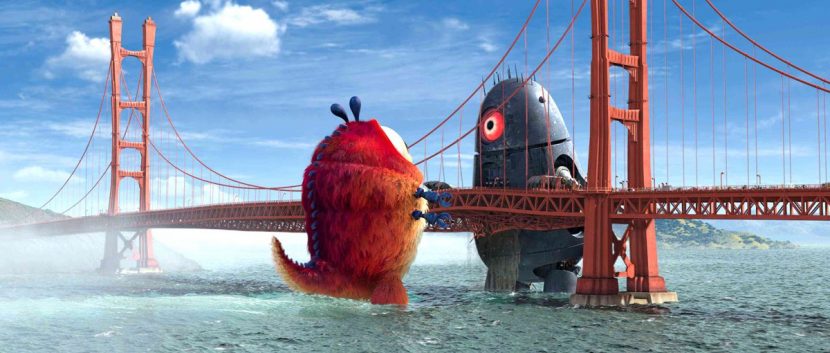
Destroying the Golden Gate isn’t just the domain of live action effects artists – animators at DreamWorks also staked their claim on bridge destruction in Monsters vs. Aliens. Here, the main character Susan (Reese Witherspoon) is chased by a giant robot over the bridge, only to be confronted by a giant alien. DreamWorks built a scale mock-up of the bridge to reference directly on their desks for the widely differing scales. Then, they treated the bridge like one of their animated characters, employing effects tools to bring a normally static model to life – or death, really, as the Golden Gate gets in the way of the bust-up.
Rise of the Planet of the Apes (2011)
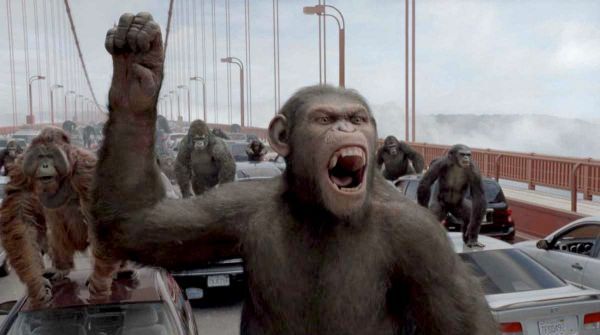
The bridge in Rupert Wyatt’s Rise of the Planet of the Apes isn’t so much destroyed in that film, rather it is overtaken by digital apes. To film bridge-level scenes, the production built an enormous set around 300 feet long and 60 feet wide surrounded on three sides by a 20 foot tall greenscreen wall. Certain parts of the super-structure and sidewalks were real, but cables and other bridge parts and surrounding environments were digital – thanks to Weta Digital, which of course also handled the CG apes and the climatic helicopter scene at the bridge.
This fantastic tutorial from The Foundry goes behind the scenes of the bridge scene, showcasing how Weta Digital’s deep compositing NUKE pipeline was used so effectively.
Pacific Rim (2013)
The epic opening to Guillermo del Toro’s Pacific Rim sees a kaiju attack on the Golden Gate – the result is a destroyed bridge where plenty of people and their vehicles ending up crashing into the water. ILM, which happens to have its San Francisco office in the Presidio looking directly onto the Bridge, was well placed to craft the digital kaiju, bridge, vehicles, fighter jets and water that make up the sequence.
Godzilla (2014)
Gareth Edwards’ Godzilla plays the titular character who you could argue is not out to destroy the Golden Gate (for once!). But our hapless Golden Gate Bridge still suffers the consequences. Godzilla surfaces from the Bay and is attacked by the military in a sequence that’s largely played out from the point of view of terrified bystanders in the vehicles on the bridge. Missiles and gunfire hit Godzilla, but they also take down sections of the bridge, rigged to crash and jiggle as the structure is disrupted.

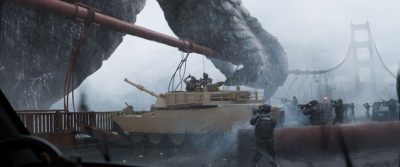
MPC was behind the digital creature, also filling out the environments with CG ships, planes, helicopters, cars and people too – plus they had to deal with the massively deforming body of water that Godzilla creates through the Bay. The studio utilized their Envirocam technique for acquiring real world photography of the Bridge and its surrounds and then generating panoramas to make up the environments. Live action for the sequence made novel use of a large set piece and inflatable greenscreen structures from Airwall – a 720ft wall in a horseshoe shape with two sides at 200ft and one at 320ft.
San Andreas (2015)
Watch part of the wave sequence.
You might have thought this Brad Peyton movie was about earthquakes – well, it is – but out of a shocking quake that rocks San Francisco emerges a giant tsunami wave that hits the Golden Gate with tremendous force, causing a container ship to buckle and twist upon the bridge. Scanline, known widely for its proprietary fluid sim toolset Flowline, delivered the destruction here. To create the bridge for shots in which it had to be digital, the production had initially considered re-using the one built for Godzilla (also a Warner Bros project). But it turns out that bridge was slightly different than the real thing. Instead, Scanline organized a tourist ‘reccy’ on the bridge to capture reference and photogrammetry. Their digital bridge, the container ship and water was then combined in simulations for the final tumultuous shots.
Terminator: Genisys (2015)
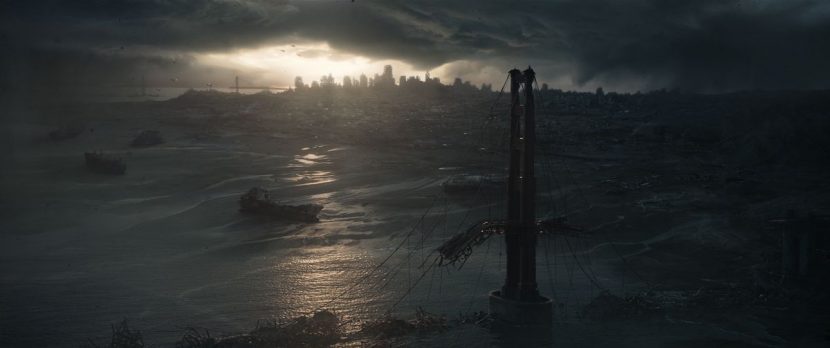
We’re not going to spoil what happens in this film, but just so you know, the bridge gets it (c’mon it was in the trailers…).
Vale the Golden Gate.
